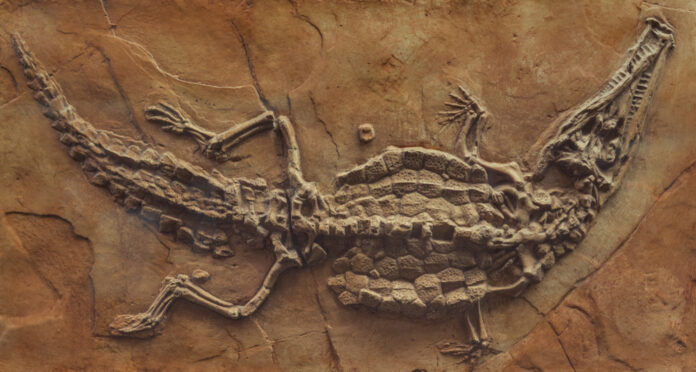One of the strangest looking crocodiles didn’t swim — it walked on land in the Late Cretaceous with a heavy set of interlocking armor and replaceable teeth.
“It has a shell on its back similar to armadillos,” says Bruno Borsoni, a master’s student in evolutionary biology at the Federal University of Rio de Janeiro in Brazil.
In fact, the extinct species’ name — Armadillosuchus arrudai — comes from a combination of the words “armadillo” and “suchus,” which means crocodile in Greek. The arrudai part refers to Brazilian paleontologist João Tadeu Arruda, who made many fossil discoveries in São Paulo state where this creature was first found.
Where was Armadillosuchus arrudai Discovered?
The armadillo crocodile was first described in 2009 in a study published in the Journal of South American Earth Sciences. Specimens of this creature have only been discovered in Brazil in the Bauru Basin, which developed roughly 80 million years ago during the Late Cretaceous.
The holotype, or first described specimen, included an almost complete skull and vertebrae and ribs, as well as parts of the creature’s shielded back. Since the initial discovery of this specimen, other partial fossil remains of the species have been found in the same deposits.
Read More: 5 Ancient Animals That Stood The Test Of Time
The Armadillo Crocodile was Unique
Armadillosuchus arrudai is the only species known in its genus, but there are more known species from its family, sphagesaurids. While crocodiles on our planet today are all semi or fully aquatic, sphagesaurids were fully terrestrial creatures, walking on limbs that were a little longer than most of their modern surviving relatives.
As far as crocodylomorphs go, the armadillo crocodile wasn’t the largest. It was medium-sized for the family, potentially growing upwards of 8 feet long from head to the end of the tail according to Borsoni — nearly a foot longer than your average NBA player lying down. The tail was likely more lizard-like, not flattened like the tails of many modern crocodiles.
But what really makes them odd is their armor, consisting of multiple pieces. Similar to the armadillos of their namesake, these interlocking pieces fit together in an accordion-like pattern along the their torsos. No other animal from the sphagesaurid family has been discovered with a similar adaptation.
Their unique teeth also differed from those of other members in the crocodile family. Rather than being super sharp, the teeth of Armadillosuchus arrudai were flatter in shape, and used for grinding at some points.
Borsoni and his colleagues recently published a study in Cretaceous Research describing the way these creatures replaced teeth. According to their analysis, Armadillosuchus arrudai replaced its teeth similar to the way that humans lose their baby teeth after several years. However, the creature would have done this throughout its life rather than just getting one set of replacements.
This new study found that, for the most part, the teeth are replaced on a regular pattern, moving one by one from the back teeth to the front and skipping a tooth every time.
“All reptiles do this, but we don’t know if they all do it exactly this way, with a wave pattern,” Borsoni says.
Read More: This Tomb Contains 10 Mummified Crocodiles From 2,500 Years Ago
What did the Armadillo Crocodile Eat?
The dullish teeth of Armadillosuchus arrudai suggest that it didn’t specialize in tearing flesh.
“The sphagesauridae is a peculiar group because they are chewing their food,” Borsoni says.
This means it was likely omnivorous, eating some plants as well as small crustaceans like snails.
It may have also burrowed sometimes, like crocodiles today — the shape of its shoulders, claws, and powerful neck and skull all suggest this, the authors of the 2009 paper noted.
Read More: Some Ancient Crocodiles Went Vegan
Predators of Armadillosuchus
The armored plate defense on the armadillo crocodile was there for a reason — a number of large predators were lurking around South America in the Late Cretaceous.
Creatures like abelisaurids, among the larger theropods in this part of South America, may have preyed on Armadillosuchus.
Another possible threat would have been Baurusuchus, a large distant cousin of Armadillosuchus in the crocodile family whose fossils were sometimes found in the same deposits.
Read More: These Extinct Giant Crocs May Have Hunted Our Ancient Ancestors
Article Sources
Our writers at Discovermagazine.com use peer-reviewed studies and high-quality sources for our articles, and our editors review for scientific accuracy and editorial standards. Review the sources used below for this article:
Joshua Rapp Learn is an award-winning D.C.-based science writer. An expat Albertan, he contributes to a number of science publications like National Geographic, The New York Times, The Guardian, New Scientist, Hakai, and others.
Source : Discovermagazine















